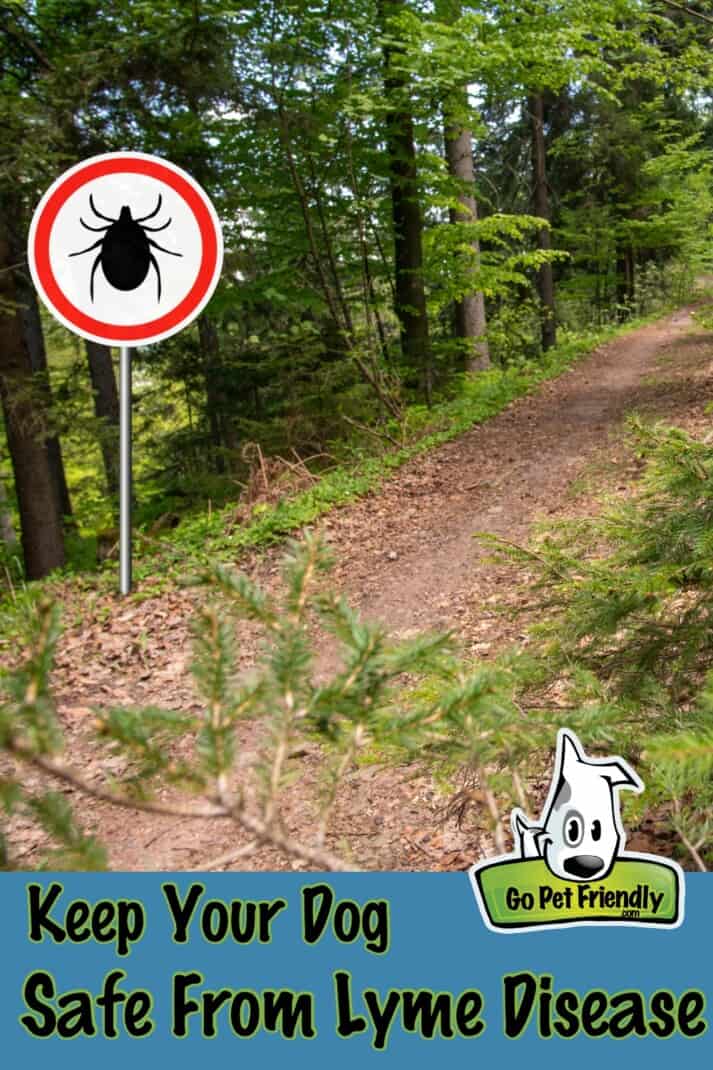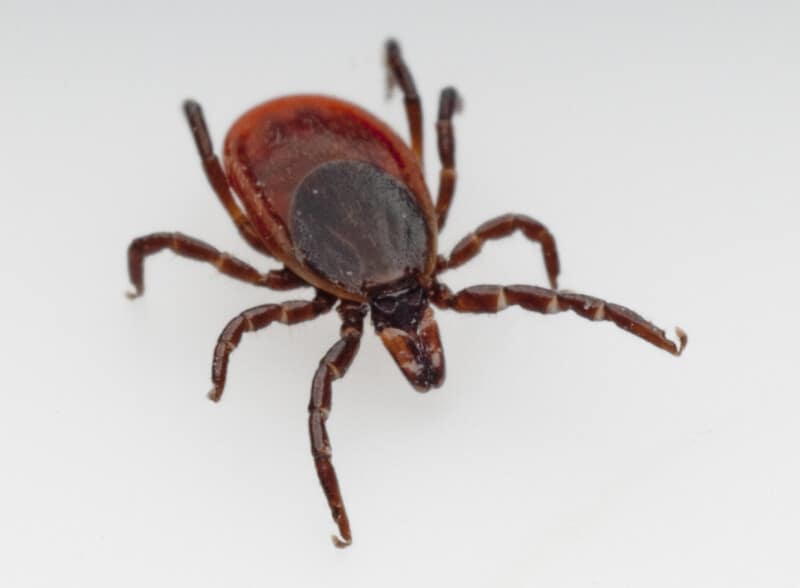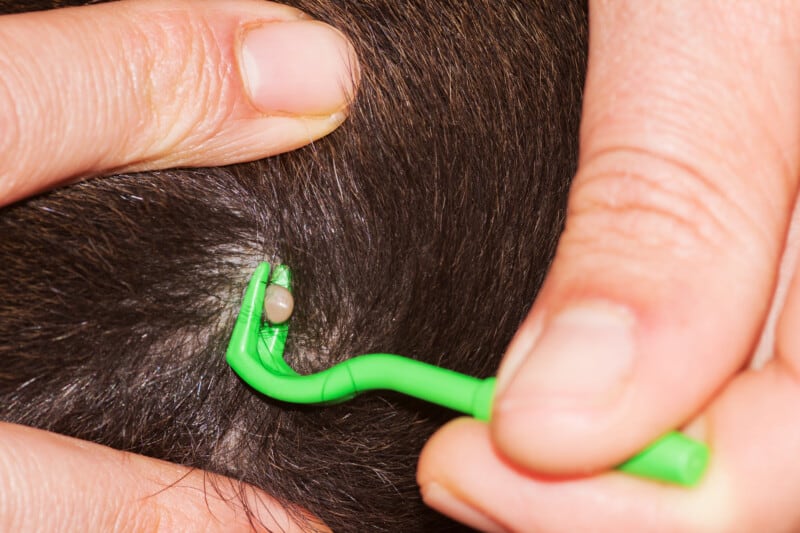Lyme disease and dogs—something you need to consider if you live in or are traveling to parts of the country where it’s endemic. But don’t worry. We have all the information you need to protect your dog.

Catching Lyme Disease
Lyme is caused by a bacterium carried by deer ticks (also known as black-legged ticks). And deer ticks are tiny! On average, they are about 3 millimeters wide. Or about the size of a sesame seed.

As you hike in the woods or high grass, these minuscule menaces hitch a ride on your dog. When they bite your pup to feed on his blood, the bacteria travels into your dog’s bloodstream. Once there, the bacteria travels throughout the body. It causes problems in specific organs or joints as well as general illness.
Your dog can carry the bacteria in her body anywhere from two to five months before showing any symptoms. Believe me, Lyme is one souvenir you don’t want to bring home from your vacation.
Symptoms Of Lyme Disease In Dogs
Most dogs don’t show symptoms after contracting the bacteria that causes Lyme disease. Others have swollen and painful joints, lameness, weakness, lethargy, loss of appetite, or fever.
Lyme can also cause kidney and heart problems, but this is rare. And severe symptoms tend to appear when the pet has had the disease for a long time. But, in the worst case, extreme cases can be fatal.
Symptoms, if they do turn up, can appear suddenly. And it’s easy to attribute joint stiffness to arthritis, especially if you have an older dog.
But stiffness due to Lyme can move from one joint to another. So if your dog is lame on the right one day and the left on the next after visiting a place where Lyme Disease is common, you might want to ask your vet to run a blood test.

Where Lyme Is Common
Lyme disease is most commonly diagnosed in the Middle Atlantic, New England, and the Upper Midwest. It also appears to be increasing in the Pacific Northwest.
READ MORE ⇒ Top Dog Friendly Things To Do In New England
Treatment For Dogs with Lyme Disease
The typical treatment for Lyme disease is a course of antibiotics. A common choice is doxycycline.

Unfortunately, this parasite is very good at hiding in the body, so you can’t count on the dog being cured after treatment. The symptoms can show up again months or years later. So you’ll have to be aware of the possibility of flare ups.
Can You Get Lyme Disease From Your Dog?
Lyme disease cannot be transmitted directly from your dog to you. However, if a tick bites your dog and then bites you, you can become infected.
READ MORE ⇒ Can You Hike The Appalachian Trail With A Dog?
Protecting Your Dog From Lyme Disease
When you’re traveling with your pets, it pays to do a little research on the types of parasites you might encounter and be prepared.
Before You Go
Several vaccinations are available for canine Lyme disease, although all vaccines carry their own risks. Deciding whether or not to vaccinate your pet is definitely a conversation to have with your veterinarian.
There are also a number of flea and tick preventatives on the market. Most that I have researched claim to kill ticks within 48 hours of it coming into contact with your treated pet. According to the American Lyme Disease Foundation, ticks begin transmitting the disease an average of 36 to 48 hours after attaching, so treating your pet will reduce their chances of infection, although it’s not a guarantee.
If your dog is sensitive to conventional flea and tick preventives, try a natural insect repellent.
Avoiding Lyme While Out And About
While hiking, encourage your dog to stick to trails. The more they explore ungroomed areas, the more likely they are to pick up ticks.

Each day you should brush your dog. Then follow up the next day with a thorough check for any little buggers you may have missed. It is easier to find ticks on dogs with light fur and short coats. So spend extra time going over your pups with double coats or dark fur.

If you find a tick has bitten your dog, it’s important to remove it thoroughly. We’ve found the best method is to use a tick twister (Amazon). You can even buy a tick remover (Amazon) to put on your key chain.

READ MORE ⇒ Bed Bugs On Dogs & Cats – Should You Worry?
Protecting Yourself From Ticks
While you’re watching out for your dog, don’t forget to keep yourself safe as well. Treat your clothing and hiking gear with products including 0.5% permethrin (Amazon). Tuck your pants legs into your socks to prevent ticks from crawling under your clothing.
The CDC also recommends applying DEET, picaridin, IR3535, Oil of Lemon Eucalyptus (OLE), para-menthane-diol (PMD), or 2-undecanone to repel ticks.

And don’t forget to check yourself and your human hiking partners for ticks as well. Especially the backs of the knees, in your hair, behind the ears, and anywhere that provides a good hiding place for pesky ticks.
Don’t Let Lyme Disease Affect Your Dog
May is Lyme Awareness Month. As you prepare for summer adventures with your pup, be mindful of protecting your dog (and yourself) from Lyme Disease. Why let a little buggy ruin your fun?
Visit our Amazon store to learn about more products we rely on to make traveling with pets easier, safer, and more fun!
Amazon Affiliate Disclosure: GoPetFriendly.com LLC is a participant in the Amazon Services LLC Associates Program, an affiliate advertising program designed to provide a means for website owners to earn advertising fees by advertising and linking to amazon.com, audible.com, and any other website that may be affiliated with Amazon Service LLC Associates Program. As an Amazon Associate, the owner of this site earns a commission from qualifying purchases.
(Visited 426 times, 1 visit today)
Comments
Post a Comment